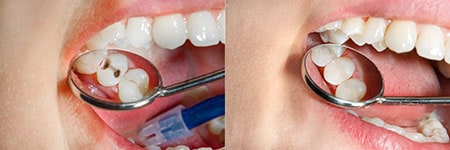
A composite (tooth colored) filling is used to repair a tooth that is affected by decay, cracks, fractures, etc. The decayed or affected portion of the tooth will be removed and then filled with a composite filling.
There are many types of filling materials available, each with their own advantages and disadvantages. You and your dentist can discuss the best options for restoring your teeth. Composite fillings, along with silver amalgam fillings, are the most widely used today. Because composite fillings are tooth colored, they can be closely matched to the color of existing teeth, and are more aesthetically suited for use in front teeth or the more visible areas of the teeth.
As with most dental restorations, composite fillings are not permanent and may someday have to be replaced. They are very durable, and will last many years, giving you a long lasting, beautiful smile.
Reasons for composite fillings:
- Chipped teeth.
- Closing space between two teeth.
- Cracked or broken teeth.
- Decayed teeth.
- Worn teeth.
How are composite fillings placed?
Composite fillings are usually placed in one appointment. While the tooth is numb, your dentist will remove decay as necessary. The space will then be thoroughly cleaned and carefully prepared before the new filling is placed. If the decay was near the nerve of the tooth, a special medication will be applied for added protection. The composite filling will then be precisely placed, shaped, and polished, restoring your tooth to its original shape and function.
It is normal to experience sensitivity to hot and cold when composite fillings are first placed, however this will subside shortly after your tooth acclimates to the new filling.
You will be given care instructions at the conclusion of your treatment. Good oral hygiene practices, eating habits, and regular dental visits will aid in the life of your new fillings.
Composite Fillings FAQs
How much do composite fillings cost?

Composite fillings are typically covered by insurance, but you may have a co-pay for the procedure. Fillings are essential in repairing damaged teeth and dental caries (cavities) and prevent tooth decay from worsening and leading to an abscess (infection) or severe pain. Composite fillings may cost between $200 and $600 without insurance, but patients with dental insurance may have a co-pay of about $100.
The price for composite fillings depends on how many teeth require treatment, the size of the cavity, the type of tooth (molar versus incisor), and the material.
People without dental insurance may qualify for financing options or discount dental plans. If you carry dental insurance, reach out to an insurance representative before your filling appointment to discuss the details of your policy.
What are the benefits of composite fillings?
Composite fillings are a quick solution for small to medium cavities or tooth damage. They require less drilling than other types of fillings or dental crowns, preserving more of the natural tooth structure. The composite material matches the shade of your surrounding teeth for a healthy and beautiful smile unmarred by amalgam (metal) fillings.
Composite material is durable and strengthens the tooth structure. However, if the filling chips or breaks, our dentist can repair the restoration. These fillings offer natural-looking results without a significant time commitment.
How long do composite fillings last?
How long your composite filling lasts depends on how well you care for your teeth and how often you have dental exams and teeth cleanings. Generally, a filling made of composite resin material lasts five to seven years. These fillings do not expand or corrode over time like silver amalgam fillings. With proper dental hygiene and bi-annual cleanings, your composite fillings could last 10 years or more.
Do composite fillings improve tooth sensitivity?
Tooth cracks and other damage can increase tooth sensitivity, as can dental caries. While you may experience more tooth sensitivity right after receiving the filling, many patients find the restoration reduces their level of sensitivity. Composite fillings may not eliminate tooth sensitivity but can improve it.
What other filling materials are available?

Fillers can be made of one or more materials to address dental cavities and tooth damage, including porcelain, gold, silver amalgam (a mixture of copper, silver, tin, and zinc), and composite resin. Composite resin is a tooth-colored material made with plastic and glass. The location and severity of the tooth decay may affect the choice of material, but composite resin is often preferred because it blends in with your natural teeth.
How long does a filling take?
The filling process involves quick bonding and hardening of the composite resin material. Most appointments take an hour or less, but your visit may be longer or shorter depending on the severity and location of the cavity or damaged tooth.
Do composite fillings require special care?
No, you can care for your filling just like your natural teeth. Brush twice daily, floss every day, and brush or use mouthwash after meals. The composite material can stain, so avoiding foods and beverages that cause tooth stains, such as wine, coffee, and tea, is best.






